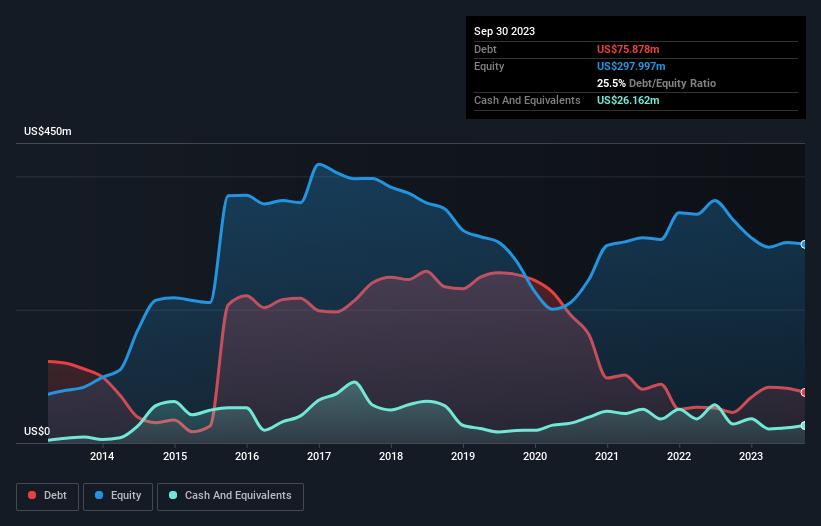Warren Buffett famously said, 'Volatility is far from synonymous with risk.' It's only natural to consider a company's balance sheet when you examine how risky it is, since debt is often involved when a business collapses. We can see that Alto Ingredients, Inc. (NASDAQ:ALTO) does use debt in its business. But should shareholders be worried about its use of debt?
What Risk Does Debt Bring?
Generally speaking, debt only becomes a real problem when a company can't easily pay it off, either by raising capital or with its own cash flow. Part and parcel of capitalism is the process of 'creative destruction' where failed businesses are mercilessly liquidated by their bankers. However, a more common (but still painful) scenario is that it has to raise new equity capital at a low price, thus permanently diluting shareholders. By replacing dilution, though, debt can be an extremely good tool for businesses that need capital to invest in growth at high rates of return. When we think about a company's use of debt, we first look at cash and debt together.
See our latest analysis for Alto Ingredients
What Is Alto Ingredients's Debt?
The image below, which you can click on for greater detail, shows that at September 2023 Alto Ingredients had debt of US$75.9m, up from US$45.9m in one year. However, it does have US$26.2m in cash offsetting this, leading to net debt of about US$49.7m.

How Healthy Is Alto Ingredients' Balance Sheet?
According to the last reported balance sheet, Alto Ingredients had liabilities of US$58.4m due within 12 months, and liabilities of US$104.7m due beyond 12 months. Offsetting these obligations, it had cash of US$26.2m as well as receivables valued at US$66.1m due within 12 months. So its liabilities outweigh the sum of its cash and (near-term) receivables by US$70.9m.
While this might seem like a lot, it is not so bad since Alto Ingredients has a market capitalization of US$166.0m, and so it could probably strengthen its balance sheet by raising capital if it needed to. But it's clear that we should definitely closely examine whether it can manage its debt without dilution. There's no doubt that we learn most about debt from the balance sheet. But it is future earnings, more than anything, that will determine Alto Ingredients's ability to maintain a healthy balance sheet going forward. So if you're focused on the future you can check out this free report showing analyst profit forecasts.
Over 12 months, Alto Ingredients made a loss at the EBIT level, and saw its revenue drop to US$1.3b, which is a fall of 8.3%. That's not what we would hope to see.
Caveat Emptor
Over the last twelve months Alto Ingredients produced an earnings before interest and tax (EBIT) loss. Its EBIT loss was a whopping US$36m. When we look at that and recall the liabilities on its balance sheet, relative to cash, it seems unwise to us for the company to have any debt. Quite frankly we think the balance sheet is far from match-fit, although it could be improved with time. Another cause for caution is that is bled US$23m in negative free cash flow over the last twelve months. So suffice it to say we consider the stock very risky. The balance sheet is clearly the area to focus on when you are analysing debt. However, not all investment risk resides within the balance sheet - far from it. Be aware that Alto Ingredients is showing 1 warning sign in our investment analysis , you should know about...
At the end of the day, it's often better to focus on companies that are free from net debt. You can access our special list of such companies (all with a track record of profit growth). It's free.
New: Manage All Your Stock Portfolios in One Place
We've created the ultimate portfolio companion for stock investors, and it's free.
• Connect an unlimited number of Portfolios and see your total in one currency
• Be alerted to new Warning Signs or Risks via email or mobile
• Track the Fair Value of your stocks
Have feedback on this article? Concerned about the content? Get in touch with us directly. Alternatively, email editorial-team (at) simplywallst.com.
This article by Simply Wall St is general in nature. We provide commentary based on historical data and analyst forecasts only using an unbiased methodology and our articles are not intended to be financial advice. It does not constitute a recommendation to buy or sell any stock, and does not take account of your objectives, or your financial situation. We aim to bring you long-term focused analysis driven by fundamental data. Note that our analysis may not factor in the latest price-sensitive company announcements or qualitative material. Simply Wall St has no position in any stocks mentioned.
About NasdaqCM:ALTO
Alto Ingredients
Produces, distributes, and markets specialty alcohols, renewable fuel, and essential ingredients in the United States.
Flawless balance sheet and fair value.
Similar Companies
Market Insights
Community Narratives




